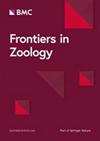利用大规模社区科学数据和计算机视觉评估温度调节作为卡洛林洋油葵生理颜色变化的自适应驱动因素
IF 2.6
2区 生物学
Q1 ZOOLOGY
引用次数: 0
摘要
兼性的生理颜色变化具有许多潜在的适应功能,绿色变色鱼(Anolis carolinensis)在棕色和绿色之间转换的能力也不例外。关于这种颜色变化的三个不相互排斥的假设包括:1)伪装假设,即个体变色蜥使用棕色和绿色来融入背景;2)社会信号假说,该假说认为,在相互作用中,颜色的变化传递了种内信号,如支配、服从和交配状态;3)体温调节假说,该假说认为,在较冷的温度下,颜色变成深棕色可以增加对太阳辐射的吸收。我们展示了计算机视觉管道的效用,从跨越美国东南部的公民科学观察的大型数据集中获得个人层面的颜色(绿色与棕色)。我们使用这些颜色信息以及气候、季节时间信息和图像背景来测试颜色变化、温度和一年中的时间之间的关联。结果表明,在冬季较低的温度下,呈现棕色的卡罗林杉更常见。然而,在夏季繁殖季节,呈现色与温度之间没有观察到相关性。我们没有发现背景颜色匹配的有力证据。我们发现了一年中依赖时间的体温调节假说和社会信号传导假说的支持,这表明多个独立的驱动因素影响着卡罗来纳草的生理颜色变化。此外,这项工作显示了利用大规模数字现场图像和机器学习来获得关于物种如何调节表型以维持其热和生物生态位最佳状态的见解的力量。本文章由计算机程序翻译,如有差异,请以英文原文为准。
Using large-scale community science data and computer vision to evaluate thermoregulation as an adaptive driver of physiological color change in Anolis carolinensis
Facultative, physiological color change has many potential adaptive functions, and the ability of the green anole (Anolis carolinensis) to shift between brown and green coloration is no exception. Three non-mutually exclusive hypotheses for such color changes include: 1) The camouflage hypothesis, which states that individual anoles use brown and green coloration to blend into their background; 2) The social signaling hypothesis, which states that coloration shifts convey intraspecific signals such as dominance, submission, and mating status during interactions; 3) The thermoregulation hypothesis, which states that shifting to darker brown coloration during colder temperatures allows for increased absorption of solar radiation as heat. We showcase the utility of a computer vision pipeline to derive individual-level color (green versus brown) from a large dataset of citizen science observations spanning the southeastern USA. We used this color information along with climate, seasonal timing information and background in images to test associations between color morph, temperature and time of year. Results show that brown-presenting A. carolinensis were observed more frequently at lower temperatures during winter. However, the observed correlation between presenting color and temperature was absent during the summer breeding season. We did not find strong evidence for background color matching. We found support for both the thermoregulatory hypothesis and social signaling hypothesis dependent on time of year, which suggests multiple independent drivers are influencing physiological color changes in A. carolinensis. Further, this work shows the power of leveraging large-scale digital field images and machine learning to derive insights about how species can regulate phenotype to maintain their thermal and biotic niche optima.
求助全文
通过发布文献求助,成功后即可免费获取论文全文。
去求助
来源期刊

Frontiers in Zoology
ZOOLOGY-
CiteScore
4.90
自引率
0.00%
发文量
29
审稿时长
>12 weeks
期刊介绍:
Frontiers in Zoology is an open access, peer-reviewed online journal publishing high quality research articles and reviews on all aspects of animal life.
As a biological discipline, zoology has one of the longest histories. Today it occasionally appears as though, due to the rapid expansion of life sciences, zoology has been replaced by more or less independent sub-disciplines amongst which exchange is often sparse. However, the recent advance of molecular methodology into "classical" fields of biology, and the development of theories that can explain phenomena on different levels of organisation, has led to a re-integration of zoological disciplines promoting a broader than usual approach to zoological questions. Zoology has re-emerged as an integrative discipline encompassing the most diverse aspects of animal life, from the level of the gene to the level of the ecosystem.
Frontiers in Zoology is the first open access journal focusing on zoology as a whole. It aims to represent and re-unite the various disciplines that look at animal life from different perspectives and at providing the basis for a comprehensive understanding of zoological phenomena on all levels of analysis. Frontiers in Zoology provides a unique opportunity to publish high quality research and reviews on zoological issues that will be internationally accessible to any reader at no cost.
The journal was initiated and is supported by the Deutsche Zoologische Gesellschaft, one of the largest national zoological societies with more than a century-long tradition in promoting high-level zoological research.
 求助内容:
求助内容: 应助结果提醒方式:
应助结果提醒方式:


